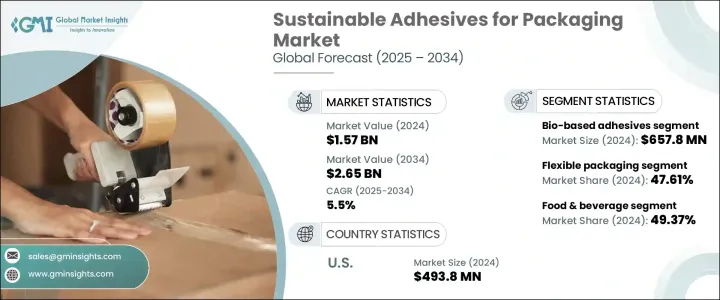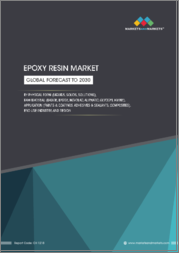
|
시장보고서
상품코드
1750508
포장용 지속가능한 접착제 시장 : 시장 기회, 성장 촉진요인, 산업 동향 분석, 예측(2025-2034년)Sustainable Adhesives for Packaging Market Opportunity, Growth Drivers, Industry Trend Analysis, and Forecast 2025 - 2034 |
||||||
세계의 포장용 지속가능한 접착제 시장은 2024년에는 15억 7,000만 달러로 평가되었고, 환경 기준 강화 및 지속가능한 포장 대한 의식의 높아지면서 CAGR 5.5%로 성장할 전망이며, 2034년에는 26억 5,000만 달러에 이를 것으로 예측되고 있습니다.
정부가 보다 엄격한 정책을 도입하고 소비자가 보다 친환경적인 대체품을 추구하는 가운데, 각 업계의 브랜드가 적응하고 환경 친화적인 접착제 솔루션에 대한 수요를 부추기고 있습니다.

개발 제조업체는 강력한 접착 성능을 발휘하면서 플라스틱 폐기물의 삭감에 도움이 되는 대체품의 개발에 점점 주력하고 있습니다. 이러한 변화는 환경에 대한 우려와 보다 지속가능한 포장 솔루션을 요구하는 소비자의 요구에 부응하는 것입니다. 게다가 순환형 경제 모델로의 이행은, 접착제의 강도, 효율성, 안전성에 타협하지 않고, 재활용성 및 재이용성의 기준을 만족시키는 접착제 처방의 혁신을 기업에 재촉하고 있습니다. 그 결과 시장에서는 바이오 기반, 재활용 가능, 생분해성 접착제 개발이 급증하고 있으며, 이들 접착제는 세계 지속가능성 목표에 부합하며 포장업계의 진화를 지속적으로 뒷받침하고 있습니다. 보다 지속가능한 접착제 솔루션을 향한 이러한 움직임은 향후 몇 년간 연포장용 접착제 시장의 성장을 가속화시킬 것으로 예상됩니다.
| 시장 범위 | |
|---|---|
| 시작 연도 | 2024년 |
| 예측 연도 | 2025-2034년 |
| 시작 금액 | 15억 7,000만 달러 |
| 예측 금액 | 26억 5,000만 달러 |
| CAGR | 5.5% |
특히 전자상거래가 세계적으로 급증하는 가운데, 기존의 포장 재료로부터의 전환이 진행되고 있는 것이 큰 추진력이 되고 있습니다. 재활용 가능, 생분해성, 퇴비화 가능한 접착제의 요구는, 특히 출하 라벨, 카톤의 씰, 연포장에 불가결하게 되어 있습니다. 연포장용 접착제가 최대 시장점유율을 차지하며 2024년에는 47.61%를 차지했습니다. 이 분야는 가볍고 범용성이 높은 포장 솔루션에 대한 수요가 높아지면서 크게 성장할 전망입니다. 이 접착제들은 특히 내구성과 안전성이 가장 중요시되는 식음료 포장에 있어서 다층 필름의 확실한 접착에 필수적입니다. 친환경 포장 재료에 대한 선호도가 높아지는 것은 지속가능성을 우선시하는 최첨단 접착제 기술의 채택을 뒷받침하고 있습니다.
바이오 기반 접착제 부문은 2024년에 6억 5,780만 달러를 생산했습니다. 이러한 제제는 전분이나 천연수지와 같은 재생 가능한 재료에서 유래하며, 강력한 접착력과 환경에 대한 영향 저감을 제공합니다. 식품에 안전한 용기나 플렉시블 파우치에 널리 사용됨으로써 지속가능성 증명과 제품 안전기준이 강화됩니다. 특히 식음료 분야의 경량 포장 요구가 플렉시블 접착제 기술의 수요를 뒷받침하고 있습니다. 산업계가 다층 필름 구조를 채택함에 따라 환경을 배려하면서 무결성을 유지하는 접착제에 대한 요구가 중요해집니다.
미국의 포장용 지속가능한 접착제 시장은 2024년에 4억 9,380만 달러에 달했습니다. 바이오 대체품을 촉진하는 연방 정부의 가이드라인 등의 규제 지원이 채용 확대에 기여하고 있습니다. 또한, 소비자 의식의 고조 및 전자상거래의 급속한 확대로 지속가능한 포장의 실천은 비즈니스상 필수 사항이 되고 있습니다. 기업은 지속 가능성에 대한 대처를 지원하기 위한 연구 개발에 고액의 투자를 실시하는 것으로 대응해, 최종적으로 시장의 기세를 가속시키고 있습니다. 보다 깨끗한 배합, 용제를 사용하지 않는 생산, 이산화탄소 배출량의 삭감에 주력하는 것은, 기업의 지속 가능성 목표나 정부가 지원하는 그린 이니셔티브에 합치합니다.
유명한 업계 리더들은 Dow, Arkema (Bostik), Avery Dennison Corporation, H.B. Fuller Company, and Henkel AG & Co. KGaA 등입니다. 시장에서의 지위를 강화하기 위해, 이들 기업은 바이오이노베이션, 지역 확대, 고도의 연구개발을 중심으로 한 전략을 채용하고 있습니다. 이러한 기업은, 퇴비화 가능한 접착제의 생산 능력을 강화해, 무용제 기술을 도입해, 특정의 기재 전용으로 커스터마이즈 가능한 접착제 솔루션을 개발하고 있습니다. 또, 포장 컨버터 및 전자상거래 리더와 전략적 제휴를 맺어, 지속 가능한 제품의 제공을 확대하고 있습니다. 클린 라벨 인증, 재활용성 시험, 녹색 제품의 시장 투입 사이클 신속화에 대한 투자는 높아지는 수요에 대응하기 위한 중요한 중점 분야입니다.
목차
제1장 조사 방법 및 범위
제2장 주요 요약
제3장 업계 인사이트
- 생태계 분석
- 업계에 미치는 영향요인
- 성장 촉진요인
- 환경에 대한 우려 증가
- 지역의 규제 의무
- 세계의 전자상거래 확대
- 친환경 포장재에 대한 소비자의 취향
- 업계의 잠재적 위험 및 과제
- 제조업체에서 고생산 코스트
- 세계적으로 한정된 원재료 공급
- 성장 촉진요인
- 성장 가능성 분석
- 규제 상황
- 기술의 상황
- 장래 시장 동향
- 갭 분석
- Porter's Five Forces 분석
- PESTEL 분석
제4장 경쟁 구도
- 서문
- 기업의 시장 점유율 분석
- 주요 시장 기업의 경쟁 분석
- 경쟁 포지셔닝 매트릭스
- 전략 대시보드
제5장 시장 추계 및 예측 : 접착제 유형별(2021-2034년)
- 주요 동향
- 바이오 베이스 접착제
- 수성 접착제
- 무용제 접착제
- 핫멜트 접착제
- 기타
제6장 시장 추계 및 예측 : 포장 형태별(2021-2034년)
- 주요 동향
- 연포장
- 경질 포장
- 라벨 및 테이프
제7장 시장 추계 및 예측 : 최종 이용 산업별(2021-2034년)
- 주요 동향
- 식품 및 음료
- 퍼스널케어 및 화장품
- 의약품
- 전자상거래 및 소매
- 기타
제8장 시장 추계 및 예측 : 지역별(2021-2034년)
- 주요 동향
- 북미
- 미국
- 캐나다
- 유럽
- 독일
- 영국
- 프랑스
- 스페인
- 이탈리아
- 네덜란드
- 아시아태평양
- 중국
- 인도
- 일본
- 호주
- 한국
- 라틴아메리카
- 브라질
- 멕시코
- 아르헨티나
- 중동 및 아프리카
- 사우디아라비아
- 남아프리카
- 아랍에미리트(UAE)
제9장 기업 프로파일
- 3M
- Arkema(Bostik)
- Ashland
- Avery Dennison Corporation
- BASF SE
- DIC Corporation
- Dow
- HB Fuller Company
- Henkel AG & Co. KGaA
- Jowat SE
- Paramelt
- Sika AG
- Toyo Ink SC Holdings
- UPM Raflatac
The Global Sustainable Adhesives for Packaging Market was valued at USD 1.57 billion in 2024 and is estimated to grow at a 5.5% CAGR to reach USD 2.65 billion by 2034, fueled by tightening environmental standards and heightened awareness around sustainable packaging. As governments introduce stricter policies and consumers demand greener alternatives, brands across industries adapt, fueling demand for eco-conscious adhesive solutions.

Manufacturers are increasingly focused on developing alternatives that help reduce plastic waste while delivering robust bonding performance. This shift is in response to environmental concerns and consumer demand for more sustainable packaging solutions. Additionally, the transition towards circular economy models is pushing companies to innovate in adhesive formulations that meet recyclability and reusability standards, without compromising on the adhesives' strength, efficiency, or safety. As a result, the market is seeing a surge in the development of bio-based, recyclable, and biodegradable adhesives, which align with global sustainability goals and continue to support the evolution of the packaging industry. This drive towards more sustainable adhesive solutions is expected to accelerate the growth of the flexible packaging adhesives market in the coming years.
| Market Scope | |
|---|---|
| Start Year | 2024 |
| Forecast Year | 2025-2034 |
| Start Value | $1.57 Billion |
| Forecast Value | $2.65 Billion |
| CAGR | 5.5% |
A major driver is the ongoing shift from conventional packaging materials, especially as global e-commerce scales rapidly. The need for recyclable, biodegradable, and compostable adhesives is becoming essential, particularly for shipping labels, carton seals, and flexible packaging. Flexible packaging adhesives hold the largest market share, representing 47.61% in 2024. This segment is poised for significant growth, driven by the rising demand for lightweight and versatile packaging solutions. These adhesives are crucial for ensuring reliable bonding of multi-layered films, particularly in food and beverage packaging, where durability and safety are paramount. The growing preference for eco-friendly packaging materials fuels the adoption of cutting-edge adhesive technologies that prioritize sustainability.
Bio-based adhesives segment generated USD 657.8 million in 2024. These formulations are derived from renewable materials like starch and natural resins, offering strong adhesion and a reduced environmental impact. Their widespread application in food-safe containers and flexible pouches enhances sustainability credentials and product safety standards. Lightweight packaging needs, especially in the food and beverage sector, propel demand for flexible adhesive technologies. As industries adopt multi-layered film structures, the requirement for adhesives that maintain integrity while being environmentally responsible becomes critical.
United States Sustainable Adhesives for Packaging Market reached USD 493.8 million in 2024. Regulatory support, such as federal guidelines promoting bio-based alternatives, is contributing to increased adoption. Additionally, the rise of conscious consumerism and the rapid expansion of e-commerce make sustainable packaging practices a business imperative. Companies are responding by investing heavily in research and development to support sustainability initiatives, ultimately driving market momentum. Focusing on cleaner formulations, solvent-free production, and reduced carbon emissions aligns with corporate sustainability goals and government-backed green initiatives.
Prominent industry leaders include Dow, Arkema (Bostik), Avery Dennison Corporation, H.B. Fuller Company, and Henkel AG & Co. KGaA. To strengthen their position in the market, these companies are adopting strategies centered around bio-innovation, regional expansion, and advanced R&D. They are enhancing production capabilities for compostable adhesives, introducing solvent-free technologies, and developing customizable adhesive solutions for specific substrates. Companies are also forming strategic collaborations with packaging converters and e-commerce leaders to scale their sustainable product offerings. Investment in clean-label certification, recyclability testing, and faster go-to-market cycles for green products is a key focus area to meet rising demand.
Table of Contents
Chapter 1 Methodology and Scope
- 1.1 Market scope and definitions
- 1.2 Research design
- 1.2.1 Research approach
- 1.2.2 Data collection methods
- 1.3 Base estimates and calculations
- 1.3.1 Base year calculation
- 1.3.2 Key trends for market estimation
- 1.4 Forecast model
- 1.5 Primary research and validation
- 1.5.1 Primary sources
- 1.5.2 Data mining sources
Chapter 2 Executive Summary
- 2.1 Industry 3600 synopsis
Chapter 3 Industry Insights
- 3.1 Industry ecosystem analysis
- 3.2 Industry impact forces
- 3.2.1 Growth drivers
- 3.2.1.1 Rising environmental concerns
- 3.2.1.2 Regional regulatory mandates
- 3.2.1.3 Worldwide e-commerce expansion
- 3.2.1.4 Consumer preferences for eco-friendly packaging materials
- 3.2.2 Industry pitfalls and challenges
- 3.2.2.1 High production costs for manufacturers
- 3.2.2.2 Limited raw material availability globally
- 3.2.1 Growth drivers
- 3.3 Growth potential analysis
- 3.4 Regulatory landscape
- 3.5 Technology landscape
- 3.6 Future market trends
- 3.7 Gap analysis
- 3.8 Porter's analysis
- 3.9 PESTEL analysis
Chapter 4 Competitive Landscape, 2024
- 4.1 Introduction
- 4.2 Company market share analysis
- 4.3 Competitive analysis of major market players
- 4.4 Competitive positioning matrix
- 4.5 Strategy dashboard
Chapter 5 Market Estimates and Forecast, By Adhesive Type, 2021 – 2034 ($ Mn & Kilo Tons)
- 5.1 Key trends
- 5.2 Bio-based adhesives
- 5.3 Water-based adhesives
- 5.4 Solvent-free adhesives
- 5.5 Hot-melt adhesives
- 5.6 Others
Chapter 6 Market Estimates and Forecast, By Packaging Type, 2021 – 2034 ($ Mn & Kilo Tons)
- 6.1 Key trends
- 6.2 Flexible packaging
- 6.3 Rigid packaging
- 6.4 Labels & tapes
Chapter 7 Market Estimates and Forecast, By End Use Industry, 2021 – 2034 ($ Mn & Kilo Tons)
- 7.1 Key trends
- 7.2 Food & beverage
- 7.3 Personal care & cosmetics
- 7.4 Pharmaceuticals
- 7.5 E-commerce & retail
- 7.6 Others
Chapter 8 Market Estimates and Forecast, By Region, 2021 – 2034 ($ Mn & Kilo Tons)
- 8.1 Key trends
- 8.2 North America
- 8.2.1 U.S.
- 8.2.2 Canada
- 8.3 Europe
- 8.3.1 Germany
- 8.3.2 UK
- 8.3.3 France
- 8.3.4 Spain
- 8.3.5 Italy
- 8.3.6 Netherlands
- 8.4 Asia Pacific
- 8.4.1 China
- 8.4.2 India
- 8.4.3 Japan
- 8.4.4 Australia
- 8.4.5 South Korea
- 8.5 Latin America
- 8.5.1 Brazil
- 8.5.2 Mexico
- 8.5.3 Argentina
- 8.6 Middle East and Africa
- 8.6.1 Saudi Arabia
- 8.6.2 South Africa
- 8.6.3 UAE
Chapter 9 Company Profiles
- 9.1 3M
- 9.2 Arkema (Bostik)
- 9.3 Ashland
- 9.4 Avery Dennison Corporation
- 9.5 BASF SE
- 9.6 DIC Corporation
- 9.7 Dow
- 9.8 H.B. Fuller Company
- 9.9 Henkel AG & Co. KGaA
- 9.10 Jowat SE
- 9.11 Paramelt
- 9.12 Sika AG
- 9.13 Toyo Ink SC Holdings
- 9.14 UPM Raflatac



















